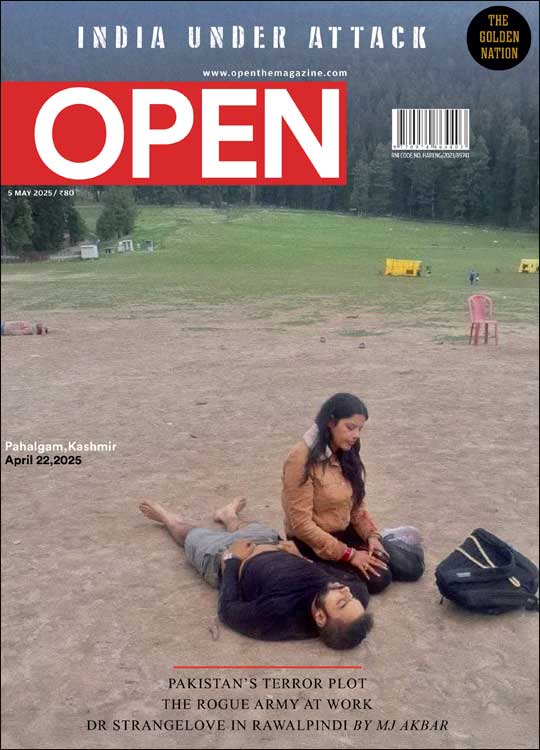Khandias: The Keepers of Doongerwadi
Khandias are the people who tend to the Parsi community’s deceased. Open listens to their stories
 Lhendup G Bhutia
Lhendup G Bhutia
 Lhendup G Bhutia
Lhendup G Bhutia
 |
15 Jul, 2015
|
15 Jul, 2015
/wp-content/uploads/2016/01/19072.doongerwadis1.jpg)
Among Parsis, Khandias are a group of people spoken about only in hushed tones. It is their job to bathe and carry the deceased of the community to the Towers of Silence for vultures, and then tend to the mortal remains, pushing them ritually into a deep pit at the centre of the circular ‘tower’ (for retrieval and burial elsewhere later). Zoroastrian corpse bearers have been at work for millennia. But in Mumbai, home to most of India’s Parsis, no vultures have been sighted for years around the city’s Towers in Doongerwadi near Malabar Hill. This exposes the corpses to the ravages of nature that make the job increasingly nerve wracking. It is rumoured that what Khandias do can be so gruesome that it cannot be undertaken without the aid of alcohol as a calming agent.
Outdated as it sounds, dokhmenashini, the 3,000-year-old tradition of disposing of the dead by exposing them to scavenger birds, remains an important tenet of the Zoroastrian faith— for it is this that’s said to assure safe passage to the after-life. In the process, however, Khandias have become the ‘untouchables’ of an otherwise casteless community. Many of them live in Doongerwadi, where the ancient tradition is practised, in close-knit quarters of their own. For centuries, they have lived under a cloak of secrecy and in near isolation of the outside world, carrying out an ancient custom hidden away in a patch of woods in the city.
On a recent weekday, I find myself sitting beside a Khandia. He’s far from a man of frazzled nerves that I had imagined. He is old and wears a pair of large dark soda glasses. I also begin to realise that he is half-deaf.
“You can’t become a Khandia,” Kersi Kohla tells me, “you are not Parsi.”
“No sir, I’m asking why you became a Khandia.”
“Why didn’t you say that?” he responds, “Well, I had a love marriage. And then I had a court marriage.”
The towers of silence are located in a verdant sprawl of 54 acres at the eastern edge of Malabar Hill. When the first dakhma, a well-like structure where bodies are laid out for vultures to consume, was built here in 1670, this area was still nowhere close to the city, and it is said tigers and hyenas were frequently spotted. More wells were built over the years, and the land itself was purchased and called Doongerwadi, a Gujarati word for ‘orchard on the hill’. The name ‘Towers of Silence’ was coined later by a 19th century British translator.
Doongerwadi is now at the centre of a busy part of the city, with tall residential buildings around its edges. Non- Zoroastrians are strictly forbidden from entering the area and there are always guards who reprimand those who try. But today, I enter the forest unopposed. At the base of the hill is a decrepit two-room quarter. Inside, a number of colourful nylon ropes crisscross the length of one room—to hang the day’s wash. Below are a group of morose men, who upon asking identify themselves as Khandias. Some of them are old, perhaps too old to be able to carry the weight of bodies, while others are younger. Each of them wears a red cap, and there is the talk of a strike on their lips. For all their years of secrecy, it appears that this mysterious sub-community has a modern demand: they want a raise.
Traditionally, there are supposed to be two types of corpse-bearers—the Khandias, who carry the bodies only up till the dakhmas, and Nassasalars, who then take the bodies in. But over the years, the division of work has got blurred.
Doongerwadi’s Khandias have now joined several other Class IV workers employed by the Bombay Parsi Punchayet (BPP), the trust that governs Doongerwadi and other Parsi properties in Mumbai, to demand better wages. According to the pallbearers, every few years their wages are increased. “But three years have passed and we haven’t received any appraisal,” says Pervez Wadia, who at 62 is the senior most Khandia. “If it is not addressed, we will go on a strike. Let people enter the dakhmas to clean it up. Then they will know.”
Around three bodies are brought here every day, according to them. “People say we are a disappearing race,” says Sam, a 41-year-old who has been a Khandia for over 19 years, his arms resting on his waist, “But by the number of bodies that come here, it doesn’t appear so.”
Perhaps the old outnumber the young, I venture.
“Oh,” Sam says, “Then we are really dying, aren’t we?” And a loud, almost macabre laughter fills the room.
Sam, unlike other Khandias, has not revealed the details of his job to all his family members, and hence wants his last name withheld. Only his wife and two sons, both of whom are students, are aware of the nature of his job. He has kept the rest, especially his in-laws, in the dark.
Sam was raised in Pune and employed as a Khandia when he was around 22 years old. He had taken up the job after failing to find any other. In the beginning, he claims, he did every chore but avoided anything that might require him to enter the dakhmas. When he eventually did, he was scared not of the half-eaten corpses and bones that lay there, but of the vultures picking on human flesh. “I used to be worried for many years,” he says, “that while they went about their task, one of the birds might look up, see me, and realise that I have more flesh to offer than a dead body. I used to sometimes feel they looked at me and considered the idea. But I realise now that they were only waiting to see what I had for them.”
Even as Sam’s fear of vultures subsided, he began to learn a different truth about his occupation. That he had become an ‘untouchable’ of sorts. Those of his family who had heard of his occupation began to keep away. And those who tipped him for his services did so without touching him—he would hold an open pouch under an outstretched hand with money. “It used to be worse before,” he says, “we would have to sit on floors, while other Parsis spoke to us from sofas or chairs. But even now, rarely will anyone ever enter our house, let alone drink or eat in our kitchens. Many don’t like us living in community baugs. So many of us prefer living with our families within Doongerwadi.”
There are some things common to most Khandias. Most are originally from places other than Mumbai. This is because, as they explain, to find someone willing to work as one isn’t easy. Every time more workers are required, the BPP sends staff members to rural areas looking for needy Parsis who might be willing to take up the job. Most of them are also men who have married women of other faiths. According to them, very rarely does someone of the Parsi community marry a Khandia, or even a relative of one. Shahrook Wadia, 55, who had to take up the job after his family fell upon bad times, was one of the rare instances. He had a Parsi wife and a young son. But she threatened to leave him when he told her about the job offer he had received. “I used to only take care of the solar panels in the beginning. But she wouldn’t understand. For her, everyone who worked at Doongerwadi was touched by death. So I did not tell her immediately,” he says. “When she learnt about it, despite us having been together for 15 years, she was gone along with my son the next day.”
To cremate the dead, according to the Zoroastrian faith, is to desecrate fire, which is regarded as holy. Burying the dead would be tantamount to doing the earth the same dishonour, and offering them to the sea or a river would sully water. The deceased are thus laid to rest in dakhmas for vultures.
This was once an efficient system. As Khandias neared the dakhmas with a body, they remember, flocks of vultures would begin circling around in anticipation, perch hungrily on the circular wall and then descend to devour the offering. Within half an hour or so, an adult body would be reduced to bones. Khandias would come later and push the bones, picked clean and bleached by the sun, into a pit at the centre.
The story now, however, is very different. Noshir Patrawala, 52, who has been working as a Khandia for over 22 years, says he last saw a vulture sometime in 2002. “We kept looking at the skies,” he says, “but none of us ever saw a vulture after that.” India once had one of the world’s largest vulture populations. The birds, it is said, thrived here because cattle slaughter is forbidden in most parts. But when the painkiller diclofenac began to be used extensively in the 90s on the country’s cattle population, the drug caused vast numbers of vultures that fed on carcasses to die of renal failure.
As vultures started vanishing from the skies, corpses at Doongerwadi began to pile up and rot in the open. The occupants of neighbouring buildings began to complain about an overbearing stench emerging from the area. With the absence of vultures, crows became more abundant. But unlike vultures, they would picked at small parts like the tongues and eyes. Sometimes they would fly off with body parts like fingers or toes, which would occasionally be found dropped in balconies and so on. Khandias would then have to go to these buildings to retrieve those parts. “We used to go to collect only whole bodies,” Sam quips, “Now we had to go collect body parts too.”
After Doongerwadi’s Khandias began to complain, the community began to search for solutions. At one point, they were instructed to sprinkle a part-herbal, part-chemical substance that was believed could hasten the decomposition of bodies. But the rains washed the chemical away during the monsoon. Later they were told to pour the chemical into the orifices of the dead. But this turned the corpses into sludge, and Khandias would often slip over human remains.
The establishment of an aviary for vultures within Doongerwadi was considered but dropped because its cost was proving prohibitive. Eventually, large solar reflectors were placed to dehydrate the bodies, a system that is still in use, before the remains are thrown into the pit. Concentrated mixtures of flowers are kept in a number of pots and ozone gas is frequently released to mask the stench, but as the Khandias claim, this does not help much. Instead, all this means more work for them. Since the reflectors can focus sunlight on only a small part of a body at any given moment, Khandias now have to drag a single corpse several times a day for it to be uniformly dehydrated. “You know,” Pervez Wadia says, “a single corpse takes at least 10 days to get fully dehydrated. But because there are so many bodies and since this whole process takes so much time compared to the old way, we are now told to dump the body, whatever its condition, into the pit after three days.”
“And during the monsoons,” Wadia continues, pointing to the cloudy sky. “Far from getting dehydrated, the rain just bloats them up and makes them heavy. Sometimes six of us have to lift a single body.”
I ask what the condition of such a body is like.
“Oh, it is bad,” says Wadia, “When we lift them, hands and legs just come apart sometimes.”
Twice every year, Khandias need to enter the pit to clean it up. Each of them earns Rs 9,000 for the task. “Have you seen a piece of bread?” Patrawala asks, offering a demonstration with his hands. “Have you seen what happens to it when it is soaked? The bodies become sticky and gooey like that. We go in, wrap each of them into sheets, carry them out, and bury them in another pit near the dakhmas.”
I meet Kohla as I leave the premises. In a raised voice, I ask what he plans to do once he comes of retirement age two years later. “I will ask for an extension,” he says. “I quite enjoy my job.”

/wp-content/uploads/2025/04/ToC-Cover-Pahalgam.jpg)











More Columns
Hindu lives too matter: US spy chief Tulsi Gabbard Open
The Line Must Move Shubhrastha
Khadi sector scaling new heights even as FMCG giants incur losses Open